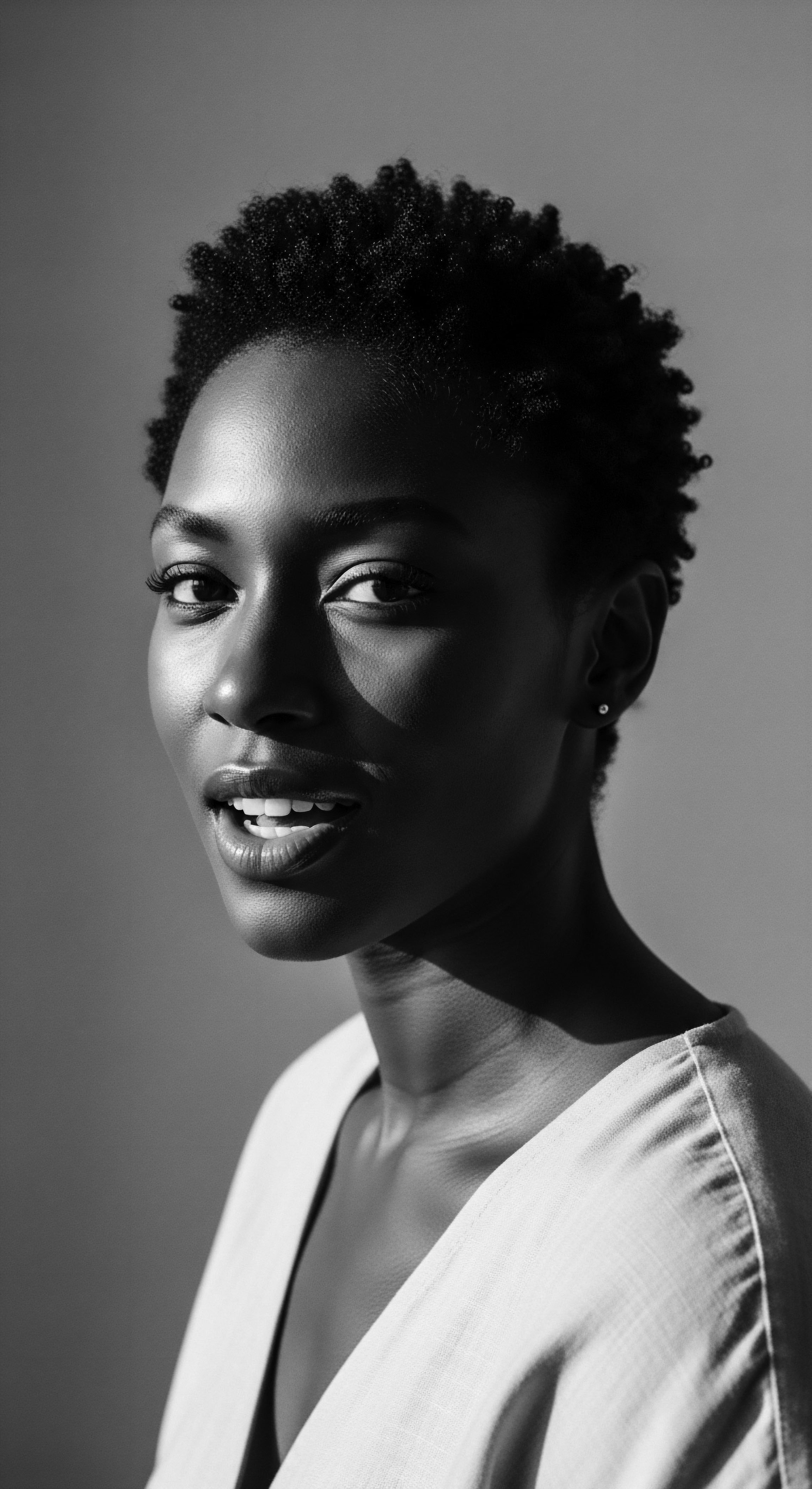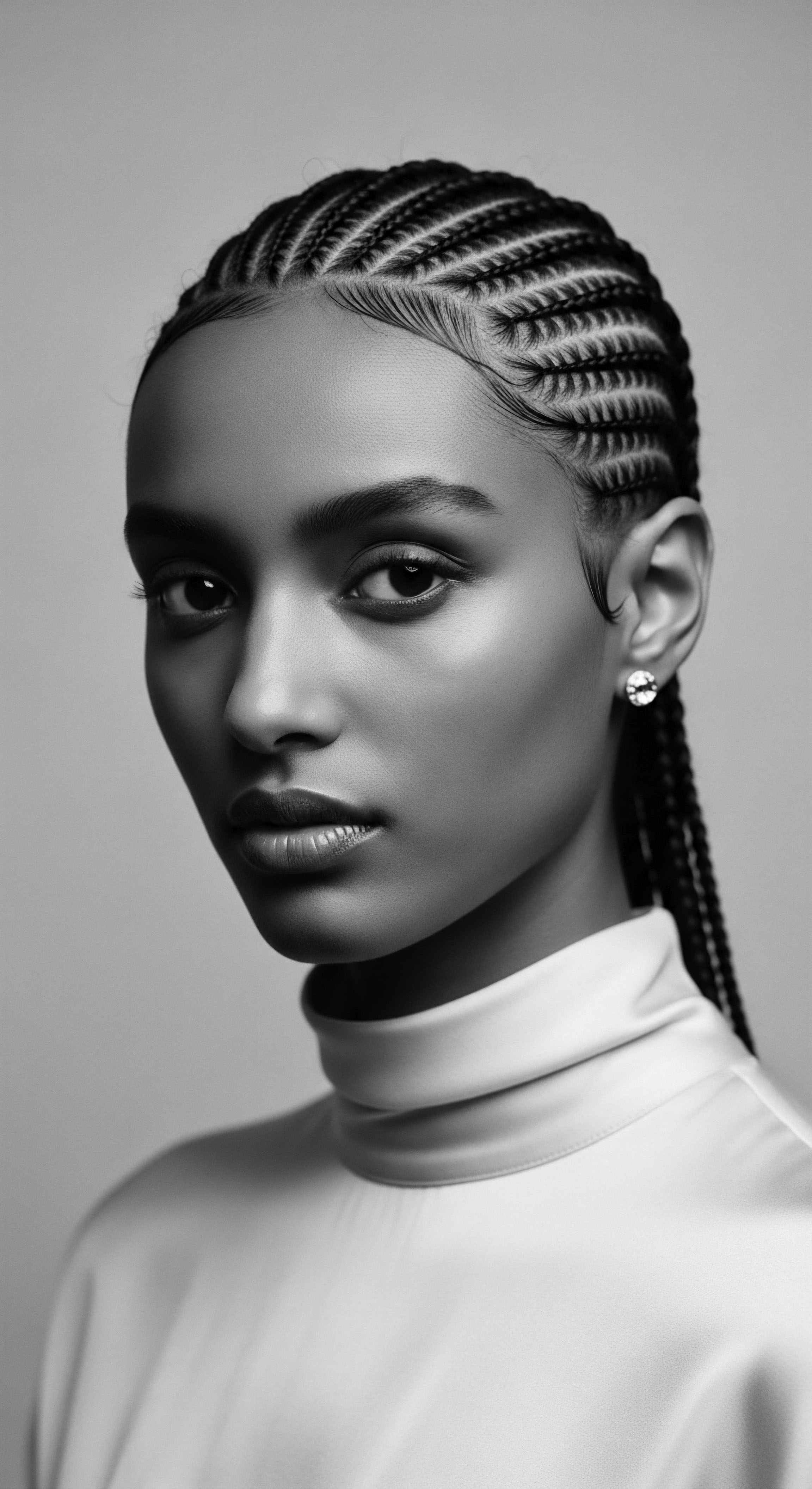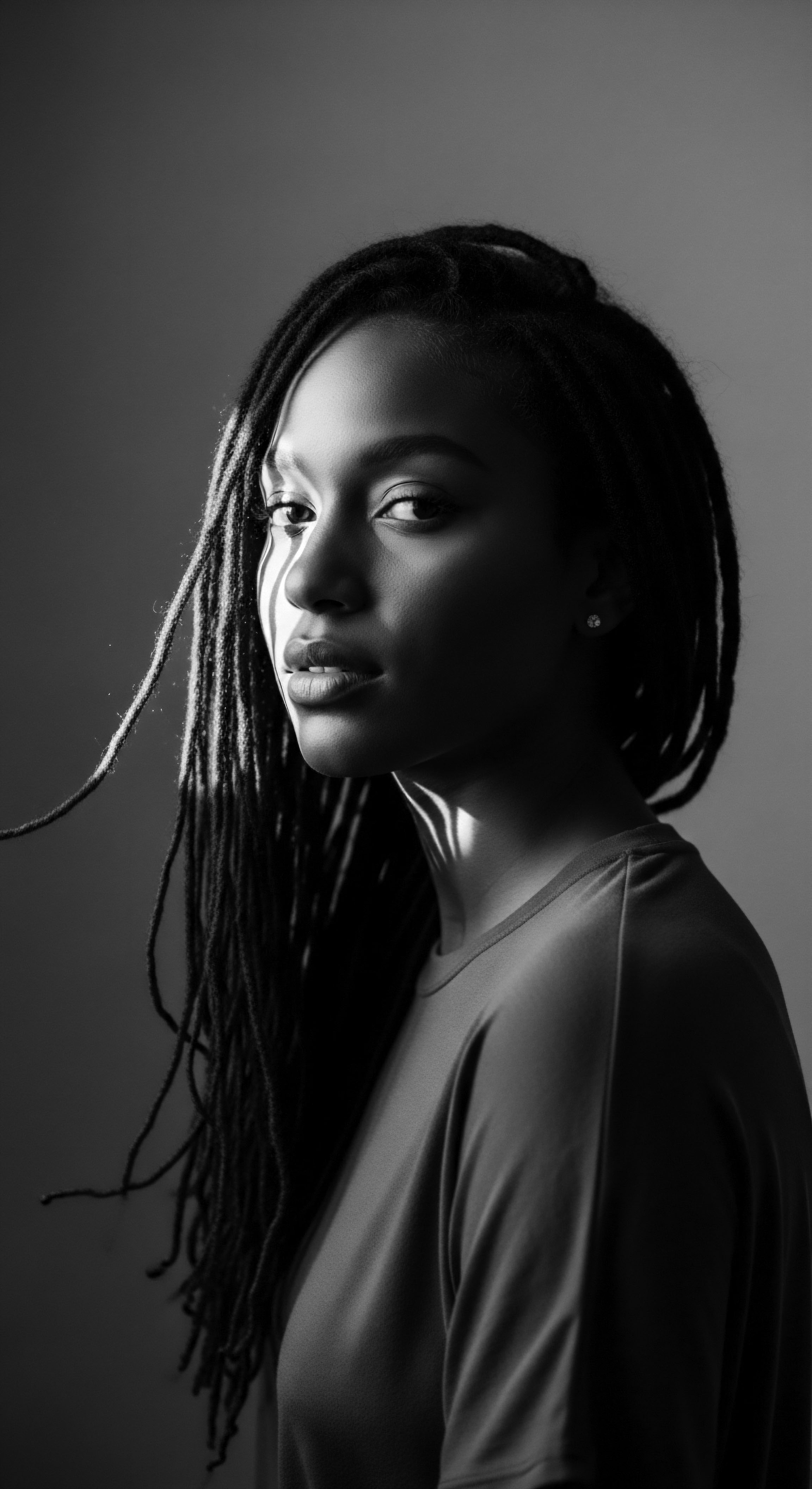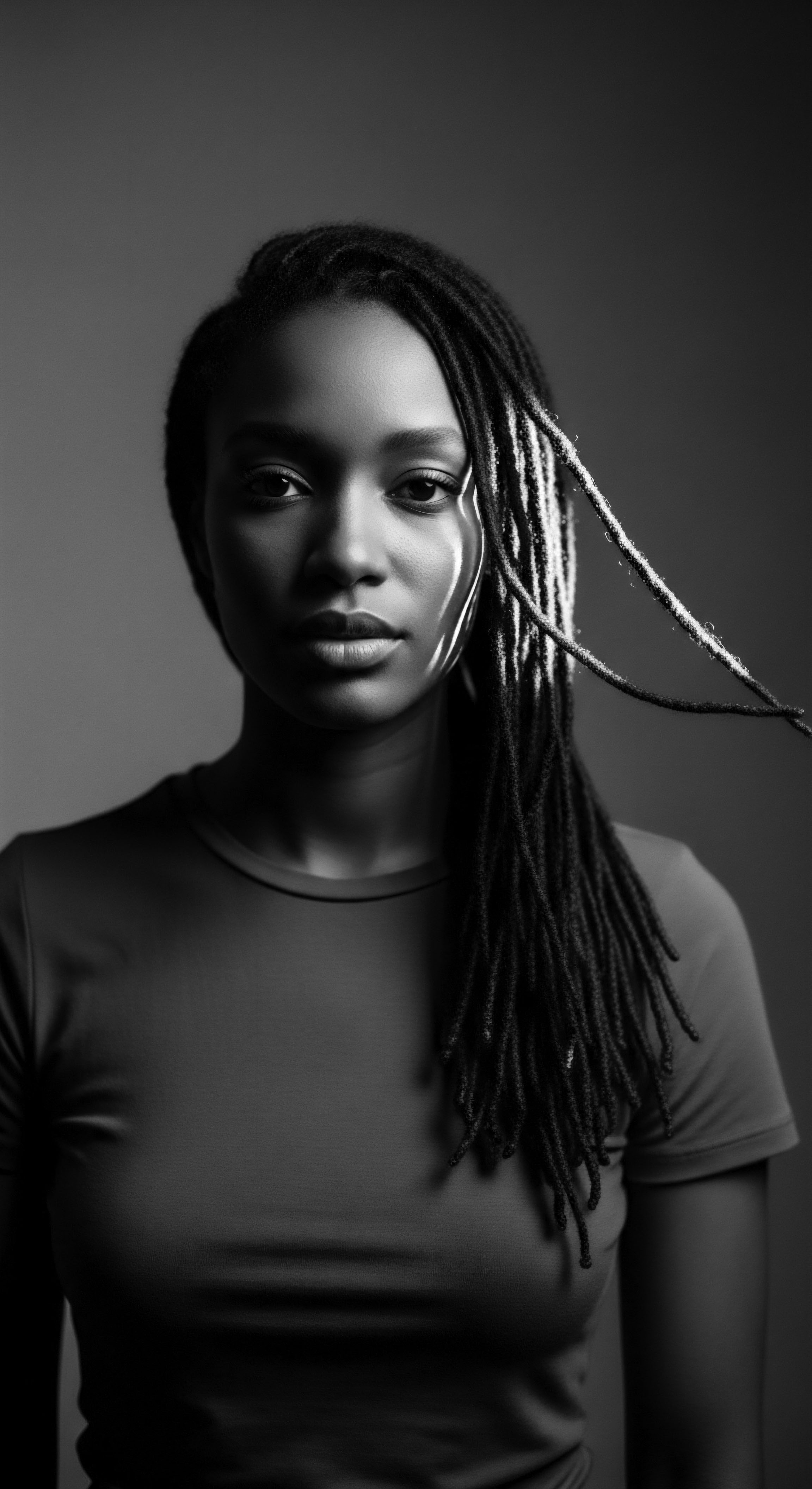
Roots
Consider for a moment the profound silent narratives etched into the very strands that spring from the scalp, a lineage of resilience and unspoken histories. For those whose ancestry traces through the intricate pathways of the African diaspora, hair is rarely a mere aesthetic choice; it is, quite often, a living document. Within this understanding, cornrows stand not simply as a styling preference, but as a deep, communicative language, a coded message carried through time, a testament to enduring spirit.
Their history is inextricably bound to the pulse of resistance, to the whispers of freedom, and to the fierce guardianship of selfhood in the face of profound adversity. This styling method, ancient and profoundly practical, holds within its tightly wound sections a heritage of survival, creativity, and persistent identity.

The Language of Lines and Lore
The patterns crafted upon the scalp in cornrows are more than decorative. In various West African societies, for generations, these designs served as visual markers, communicating a person’s age, marital status, tribal affiliation, wealth, or even spiritual standing. This intricate system of communication was carried across the Atlantic during the transatlantic enslavement, transforming within the crucible of oppression into tools for survival. The very act of braiding became a quiet act of preservation, ensuring that ancestral knowledge, though under constant assault, would persist.
In the dense jungles of what is now Colombia, a particular, haunting story of cornrows providing a physical roadmap to liberty still resonates. During the Spanish colonial era, enslaved people in places like Cartagena often designed their cornrows to resemble actual escape routes from plantations into the dense, protective forests or through swamps. The lines and curves of the braids could mirror rivers, roads, or even mountain ranges, creating a living, wearable map, invisible to the enslavers who saw only an ‘ethnic’ hairstyle.
Cornrows have served as a silent yet potent language, conveying identity and strategy across generations.
Beyond cartography, cornrows provided another crucial service during these harrowing times. Small, precious items could be secreted within the braids. Seeds of staple crops—rice, okra, millet, black-eyed peas—were hidden within the tightly woven sections of hair, transported from the Old World to the New.
This practice ensured the survival of vital food sources and, with them, a tangible link to ancestral homelands and agricultural practices. This was not simply about sustenance; it was about maintaining a connection to a past and building a future, sowing the literal seeds of self-sufficiency and communal life outside the oppressive system of enslavement.

What Did Cornrows Conceal During Enslavement?
The genius of cornrows in resistance also lay in their capacity for concealment. The hair, often overlooked by oppressors as a site of strategic information, became a canvas for clandestine operations.
- Seeds ❉ Tiny grains of rice, corn, okra, and other essential crops, smuggled from Africa, ensured food security in new, hostile environments and helped establish independent Maroon communities.
- Gold Dust ❉ On occasion, precious gold dust or other small valuables could be tucked within the braids, providing a means of trade or eventual purchase of freedom for individuals or communities.
- Messages ❉ Though less common than maps or seeds, the very patterns themselves or small rolled notes could be woven into the braids, transmitting information between enslaved people, particularly during revolts or escape planning.
The structural resilience of textured hair, capable of holding these forms and items, certainly played a part in this historical utility. The hair’s natural coils and strength allowed for designs that remained intact for extended periods, preserving their hidden messages or precious cargo. This inherent quality of the hair itself became an ally in the quest for emancipation.
| Purpose Covert Mapping |
| Heritage Connection Maintaining navigational knowledge for freedom. |
| Physical Aspect Utilized Braiding patterns mimicking landscapes. |
| Purpose Seed Preservation |
| Heritage Connection Securing ancestral crops for survival. |
| Physical Aspect Utilized Dense, hidden pockets within braids. |
| Purpose Information Exchange |
| Heritage Connection Silent communication among the enslaved. |
| Physical Aspect Utilized Visual codes and tactile concealment. |
| Purpose These practices underscore cornrows' role as a vessel for ancestral knowledge and resistance. |
The deliberate choice to maintain these traditional styles, even under the threat of punishment, was a profound act of self-preservation and cultural fidelity. It was a visible declaration of an identity that refused to be erased, a silent roar against the dehumanizing forces of enslavement.

Ritual
The shaping of cornrows is a ritualistic act, often a communal one, connecting the present to a continuum of ancestral practices. During times of resistance, this ritual itself deepened its layers of meaning, moving beyond mere hair care to become a sacred ceremony of cultural preservation and quiet defiance. The hands that braided were not simply styling; they were transmitting stories, reinforcing communal bonds, and encoding the very heritage of a people.
The meticulous nature of cornrowing, often taking hours, created intimate spaces where knowledge could be shared in hushed tones, away from the ears of oppressors. These moments of shared vulnerability and purpose forged unbreakable ties, sustaining hope and collective resolve.

How Did Braiding Foster Community Resilience?
The physical act of creating cornrows inherently fosters community. During enslavement and in subsequent periods of systemic oppression, these braiding sessions provided crucial opportunities for interaction that were otherwise denied. Imagine a group of women, their heads bowed, fingers moving rhythmically through textured strands.
In this quiet tableau, secrets were exchanged, strategies discussed, and solace offered. It was a space where the trauma of the outside world could, for a precious moment, recede, allowing for the sustenance of spirit.
This communal aspect extended beyond simple conversation. It was a practical sharing of labor and expertise. Younger generations learned from elders, absorbing not just the technique of braiding, but the cultural significance, the meaning behind certain patterns, and the ancestral wisdom related to hair care itself. This oral tradition, passed through the generations, was a powerful bulwark against cultural dissolution.
Cornrows became a visible manifestation of shared identity, a silent testament to a collective history that refused to be fragmented. The continuity of these practices, from African homelands to the diaspora, speaks to an extraordinary tenacity.
The communal act of cornrowing created intimate spaces for knowledge transfer and mutual support amidst adversity.
In the context of resistance movements, particularly the Civil Rights Movement in the mid-20th century, cornrows resurfaced with renewed vigor as a symbol of Black pride and a rejection of Eurocentric beauty standards. The decision to wear natural styles, including cornrows, was a political statement. It was a visible manifestation of self-acceptance and a reclamation of identity that had long been suppressed. Activists wore their cornrows as a badge of honor, signaling their solidarity with the struggle for liberation and challenging the pervasive notion that Black hair was “unprofessional” or “unruly.”

What Ancestral Hair Practices Informed Resistance Styling?
The techniques and care involved in cornrowing are deeply rooted in ancestral practices, carrying forward methods of manipulation and adornment that predated colonial encounters. The understanding of textured hair’s unique structure and needs, passed down through generations, allowed for the creation of styles that were not only aesthetically significant but also practical and protective.
Key aspects of these ancestral hair practices that contributed to resistance styling include:
- Protective Design ❉ Traditional cornrows, by keeping hair neatly sectioned and close to the scalp, minimized tangling and breakage, preserving hair health over extended periods, a practical benefit crucial during long journeys or periods of instability.
- Natural Product Use ❉ Knowledge of indigenous oils, butters, and herbs—like shea butter or coconut oil—was applied during braiding to moisturize and protect the hair. This traditional botanical wisdom sustained hair and scalp health, reflecting a holistic approach to wellbeing.
- Symbolic Adornment ❉ While less about hiding objects in modern resistance, the incorporation of beads, cowrie shells, or specific partings often carried symbolic meaning, indicating status, spirituality, or a connection to specific cultural groups, thereby reinforcing identity.
The continuity of these practices, even when performed under duress, was a powerful act of cultural agency. It asserted a right to self-definition and maintained a link to a heritage that colonizers and enslavers sought to obliterate. The precise, methodical nature of braiding, the division of hair into uniform sections, speaks to a deep understanding of geometry and symmetry, knowledge often encoded within these traditional practices. It is a subtle science, passed down, reflecting an innate intelligence about the nature of hair and its interaction with the scalp.

Relay
The journey of cornrows from ancient practices to modern expressions of identity and defiance is a continuous relay, a baton passed through time, carrying the weighty legacy of resistance. This stylistic continuum is not simply about aesthetics; it is a profound testament to the enduring power of cultural memory and the ways in which a singular practice can hold layers of meaning across centuries and continents. From the whispered maps of the enslaved to the unapologetic crowns of Civil Rights activists, cornrows have consistently served as a visible manifestation of Black autonomy and the refusal to yield. This legacy has also been studied within the framework of semiotics, where hair styles function as non-verbal communication, capable of transmitting complex social and political messages (Mercer, 1994).

How Do Cornrows Signal Identity and Resistance Today?
In contemporary society, cornrows continue their historical role as a powerful symbol. For many, wearing cornrows is a direct acknowledgment of their heritage, a connection to the resilience of their ancestors, and a quiet protest against lingering anti-Black hair biases. The natural hair movement, which gained significant momentum in the 21st century, saw a resurgence of cornrows as individuals consciously chose to reject chemical alterations and embrace their hair’s natural texture. This choice, while personal, carries collective weight, challenging beauty norms that have historically marginalized Black people.
The visual declaration of cornrows in professional spaces, educational institutions, and public life often serves as an act of resistance against conformity. Despite legal protections like the CROWN Act in some regions of the United States, discrimination based on hair texture and style persists (The CROWN Act, 2019). The presence of cornrows in these settings directly challenges such biases, asserting the right to cultural expression and individual authenticity. This continuous push for acceptance and validation reflects a long historical battle for Black self-determination.
Consider the phenomenon of professional athletes and entertainers, particularly those of African descent, wearing cornrows on global stages. Their choice broadcasts a powerful message of pride and cultural affirmation to millions. This public display normalizes and celebrates a hairstyle historically associated with oppression and marginalization, transforming it into a global symbol of strength and identity. It is a visual relay of historical narratives, now playing out in the contemporary arena.
Modern cornrows stand as a living testament to Black pride and a sustained challenge against Eurocentric beauty standards.
The very geometry of cornrows, the systematic division of the scalp, and the uniform plaiting, can be viewed through a scientific lens as an intelligent manipulation of the hair’s keratin structure. This manipulation, passed down through generations, effectively protects the hair from environmental stressors and mechanical damage, preserving its integrity. The long-standing efficacy of cornrows as a protective style, validated by modern trichology, underscores the ancestral knowledge embedded within the practice.

What Is the Sociopolitical Significance of Cornrows?
The sociopolitical significance of cornrows extends beyond individual expression, reaching into the collective consciousness of the diaspora. They serve as a visible shorthand for shared experience, a non-verbal narrative of overcoming.
Their significance is multifaceted:
- Defiance Against Assimilation ❉ Cornrows represent a conscious rejection of pressures to conform to Western beauty ideals, reaffirming a distinct cultural aesthetic.
- Symbol of Solidarity ❉ Wearing cornrows can signify unity within Black and mixed-race communities, a shared understanding of historical struggle and contemporary identity.
- Historical Memory ❉ The style serves as a constant, visible reminder of ancestral ingenuity, survival tactics, and the enduring spirit of resistance. It is a living archive.
- Political Statement ❉ In certain contexts, cornrows can be a deliberate political statement against systemic racism, a claim to space and visibility for Black bodies and cultures.
As documented by Byrd and Tharps (2001), Black hair, including cornrows, has historically been a site of political contestation and cultural expression. Their research emphasizes how hairstyles have reflected broader societal shifts and movements within the African American community, from slavery to the Civil Rights Movement and beyond.
| Aspect Primary Function |
| Historical Context (e.g. Enslavement Era) Covert communication, concealment of goods, escape mapping. |
| Contemporary Context (e.g. Natural Hair Movement) Cultural affirmation, anti-discrimination statement, identity expression. |
| Aspect Risk Involved |
| Historical Context (e.g. Enslavement Era) Severe punishment, violence, potential death. |
| Contemporary Context (e.g. Natural Hair Movement) Workplace discrimination, social prejudice, microaggressions. |
| Aspect Visible Message |
| Historical Context (e.g. Enslavement Era) Survival, defiance, hope for freedom. |
| Contemporary Context (e.g. Natural Hair Movement) Pride, authenticity, self-acceptance, heritage celebration. |
| Aspect The fundamental role of cornrows as a conduit for resistance endures, adapting to the challenges of each era. |
The legacy of cornrows in resistance movements is not static; it is dynamic, evolving with each generation while retaining its core message of strength and heritage. The very structure of the hair, its ability to be sculpted and held, allowed for this historical utility. This inherent biological characteristic of textured hair was harnessed by ingenuity and necessity, giving birth to a practice that speaks volumes without uttering a single word.

Reflection
The saga of cornrows, from silent cartography to vibrant declarations of self, beckons us to look beyond the surface of a style and into the deep currents of human experience. It is a tale etched not in parchment, but in the resilient coils and curves that crown heads across the globe. Each strand, meticulously guided into formation, carries the memory of ancestors who whispered hope and defiance into every braid. This enduring practice underscores the powerful, often understated, role of personal expression in grand movements for liberty.
The ‘Soul of a Strand’ ethos reminds us that our hair is more than keratin; it is a repository of shared history, a testament to enduring wisdom, and a living legacy passed from hand to hand, generation to generation. As we observe the intricate patterns of cornrows today, we are, in a profound sense, witnessing the continuity of a deeply rooted heritage, still breathing, still speaking, still guiding the way forward.

References
- Byrd, Ayana D. and Lori L. Tharps. 2001. Hair Story ❉ Untangling the Roots of Black Hair in America. St. Martin’s Press.
- Mercer, Kobena. 1994. Welcome to the Jungle ❉ New Positions in Black Cultural Studies. Routledge.
- The CROWN Act. 2019. The Crown Act ❉ Creating a Respectful and Open World for Natural Hair. Official Legislative Documents, California. (This refers to a legislative act, not a book/paper, but provides context for modern resistance).
- Sweet, James H. 2003. Recreating Africa ❉ Culture, Kinship, and Religion in the African-Portuguese World, 1441-1770. University of North Carolina Press.
- Fussell, Susan. 1991. Concealing and Revealing ❉ Hair as a Symbol in African American Culture. The Journal of American Culture 14(2) ❉ 39-44.
- Hooks, Bell. 1992. Black Looks ❉ Race and Representation. South End Press.
- Thompson, Robert Farris. 1983. Flash of the Spirit ❉ African and Afro-American Art and Philosophy. Vintage Books.
- Gates, Henry Louis Jr. 1988. The Signifying Monkey ❉ A Theory of Afro-American Literary Criticism. Oxford University Press.
